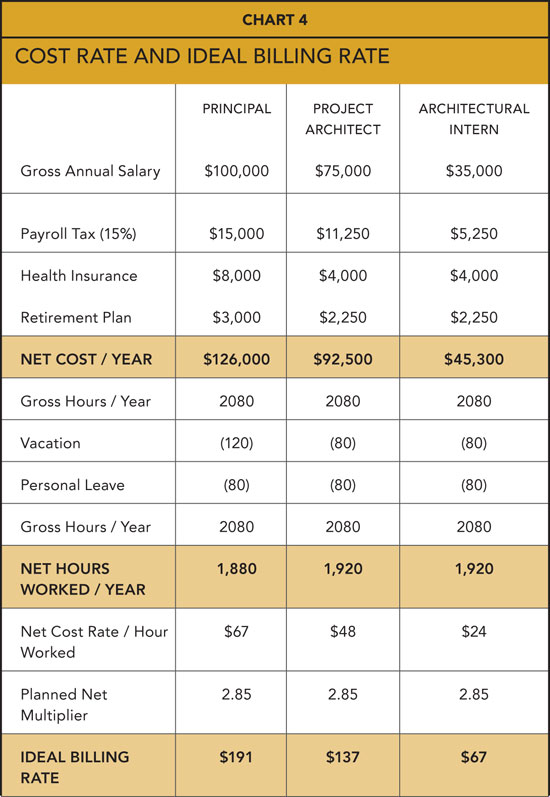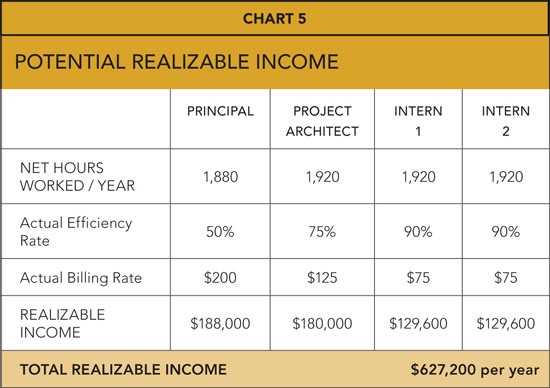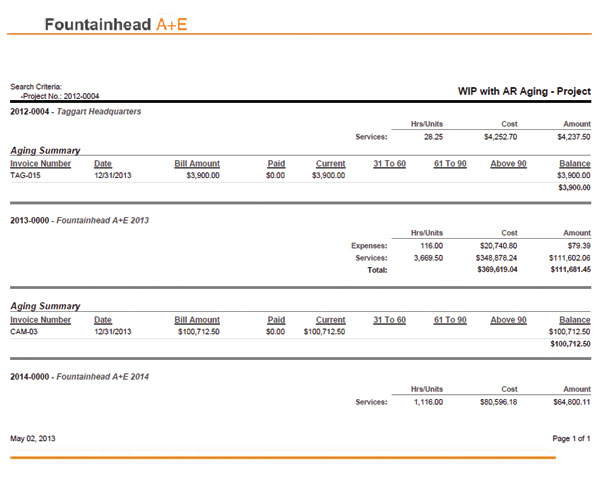Effective Financial Management of Architectural Firms
Setting Ideal Billing Rates
Why is the planned net multiplier so magical? First, it's an incredibly important number to help the firm determine what the minimum hourly billing rates should be for the firm's staff. To show how this works, have a look at each type of staff member in the firm in Chart 4.

So taking into account all the factors for professional salaries and benefits—and how many hours the firm's staff members will work —provides a net cost to the firm for each hour worked. The magical multiplier is then used to get the ideal billing rate. And as long as this architecture office maintains the 65 percent efficiency rate determined earlier, the firm must bill accordingly to get the desired level of profit: the principal at $191/hour, the project architects at $137/hour, and the architectural interns at $67/hour.
Note that in some cases, architecture firms prefer to use an efficiency rate specific to each firm role or job function. So instead of using a “global efficiency rate” for the whole firm, they will evaluate their ideal billing rate for each employee based on their true efficiency levels. (That's a reasonable approach, too, but it's not covered in this learning unit.)
Using these values determined above, the architecture firm can then predict the likely potential value of the employees. This calculation is called the projected realizable income (see Chart 5), and it helps determine a valuable aspect of how the firm must be managed.

The valuable information is also good news: It shows that at the firm's planned billing rates, the potential income is greater than planned. Specifically, the total realizable income of $627,200 exceeds the $500,000 projected in the firm's profit plan. So the firm could invoice 80 percent of its potential and still hit the goals set forth in the profit plan.
It sounds like good news, and actually it's typical, according to experts in architecture firm management. This is a very common position for most firms, and they obviously would like to bill the full potential of the staffing and predicted efficiencies. Considering that the principal will be spending half of his or her time working on non-billable things, we would hope that these efforts are what will continue to bring new work into the firm.
Summarizing the key data required to run a financially successful firm, the Houston-based management consultant Steve L. Wintner, AIA, listed 10 key indicators in his AIA best-practices article, “Financial Management: 10 Key Performance Indicators”:
▶ 1. Utilization rate. As reviewed above, the utilization rate is not a measure of efficiency, but rather the percentage of hours spent on billable projects out of total available working hours. It is not a measure of productivity. “A reasonable goal for the entire staff would be a utilization rate of 60 percent to 65 percent,” wrote Wintner, the founder and principal of Management Consulting Services, Houston, “and for professional and technical staff—including principals—a reasonable goal would be 75 percent to 85 percent.”
▶ 2. Overhead rate. Comparing the cost of expenses not related to projects as a portion of total direct labor gives a percentage, which is the overhead rate. This rate must be known in order to determine an architecture firm's profit. Low is best for this rate. Wintner cautions that if the overhead rate is greater than 1.75 times total direct labor, the firm should immediately consider corrective actions.
▶ 3. Break-even rate. Just add 1.0 to the overhead rate and that's the firm's break-even rate. For example, if the overhead rate is in the danger zone of 1.75, the firm must earn $2.75 for every $1.00 it spends simply to break even. Wintner observes that each firm employee has a break-even cost: “the overhead rate plus each person's hourly salary.” So the break-even rate for the example above is 2.75 times the hourly salary, which for the $24.00 per hour intern in the example on the previous page, would be $66.00 per hour—just to break even on the intern's work.
▶ 4. Net multiplier. This compares firm revenues as a portion of total direct labor. It should be greater than the break-even rate—because that means the firm is profitable!
▶ 5. Profit-to-earnings ratio. If an architecture firm is effective at completing building projects profitably, they should have a higher profit-to-earnings ratio. To calculate the firm's profit-to-earnings ratio, just divide the pretax profit by net operating revenue.
▶ 6. Aged accounts receivable. Invoices should be paid as fast as possible. Within 60 days is typical, and anything beyond that should be addressed immediately. The measure aged accounts receivable helps identify the average age or length of time accounts receivable are outstanding. To calculate it, first divide the firm's net operating revenue by 365 days. Then take the last 12 months of accounts receivable to get the average annual figure, and divide this by the daily net operating revenue figure just calculated previously. In other words:
Average annual unpaid fees ÷ (net operating revenue ÷ 365)

Image courtesy of BQE Software
For a work in progress, the measure of aged accounts receivable helps identify the length of time invoices remain unpaid.
▶ 7. Proposals pending. On the other hand, a firm can review its strengths and weaknesses at creating winning proposals—and more importantly, generating enough proposals to earn enough future revenues. This calculation includes prospects, says Wintner, which are “proposals that the firm has a 50 percent or better chance of winning,” as well as suspects, where the proposals are estimated “to have a chance of winning of less than 50 percent.” Add up the total dollar amount of prospects and suspects and compare the total to annual net operating revenue: Proposals pending should be about 2.5 or three times net operating revenue—with the caveat that prospects run at least equal to net operating revenue and suspects at about 1.5 to two times net operating revenue.
▶ 8. Backlog volume. Another good measure of a firm's short-term business robustness is backlog volume, the unbilled portion of current contracts. Monthly invoices are a good thing, of course, but they also erode backlog volume. To stay healthy, a firm wants to replace any fees invoiced with newly contracted fees. Wintner and other experts advise that savvy firms push hard to keep their backlog volumes at least equal to annual net operating revenue, if not much greater.
▶ 9. Net revenue per employee. Easy and revealing, too: Just divide annual net operating revenue by the number of employees. This measure helps to predict future yearly net operating revenue, says Wintner, who has been a licensed architect since 1968 and also past chair of the AIA Practice Management Committee.
▶ 10. Cash flow. For architecture firms, cash flow is what separates the great-struggling firms from the great-successful firms. It's worth a detailed discussion.









